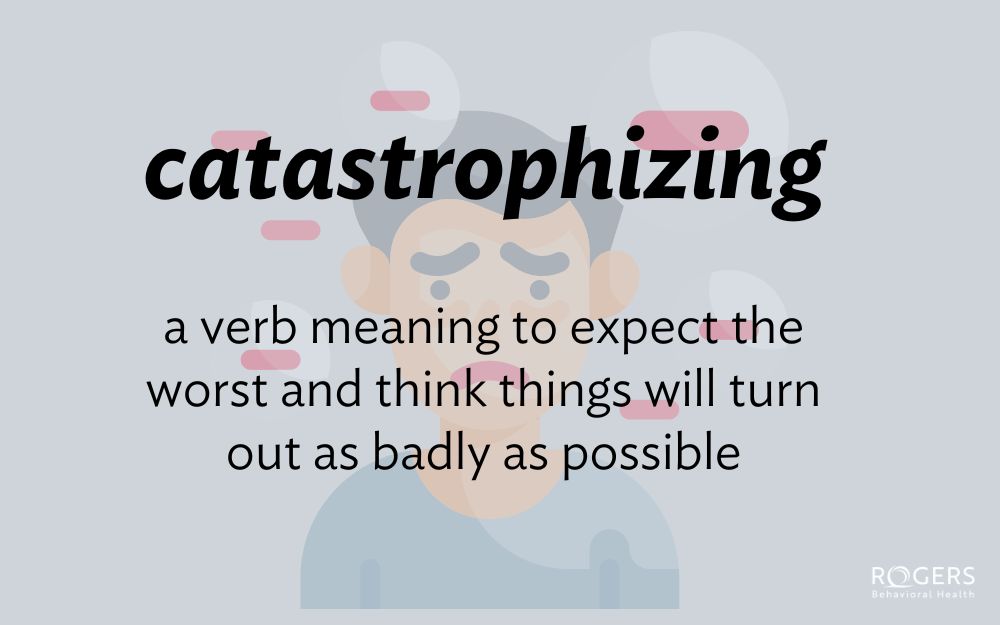
By Maria Recker, therapist, Rogers in Appleton
What is catastrophizing?
Catastrophizing is when someone always expects the worst and thinks things will turn out as badly as possible. This is where the expression, “Making a mountain out of a molehill” comes into play.
What are examples of catastrophic thinking?
An example of catastrophizing is when a person with health anxiety feels a physical sensation. They might quickly think they have cancer and are dying. A student worried about a homework mistake might start to fear failing the class. They may worry about dropping out of school, not getting a good job, and even becoming homeless. The thought pattern involves imagining situations as not just challenging or unpleasant, but potentially dangerous or disastrous.
Are people who catastrophize naturally pessimistic?
I don’t think so. I bet if asked, many will say they’re just being realistic. To me, pessimism is resigning yourself to the idea that everything will be bad. Catastrophizing is when a person worries about unpleasant outcomes as a way to feel protected. The thought process would be something like, “If I can predict every potential awful scenario, then I can prepare myself for it or prevent it and remain safe.”
I think people who catastrophize often hold beliefs that danger is always present or that things might go wrong at any point, so they feel it’s important to stay vigilant and do everything in their power to prevent bad outcomes. This tendency could stem from having experienced a significant negative event, leading their brain to confuse the possibility of danger with its probability, making them alert to potential threats. If someone grew up with a highly anxious parent who taught them the world is a dangerous place, they will likely grow up believing that and practicing what they saw to avoid any perceived risks.
What causes catastrophic thinking?
I don’t think anyone is immune to negative thinking patterns. Think about how often you’ve Googled a physical symptom, read that is has a bad outcome, and even if only for a short time, believed it.
People with depression, OCD, or anxiety disorders specifically are more likely to fall into negative thinking patterns. Studies show that people with anxiety disorders tend to be more intelligent and more creative, and I think that’s because in every situation, they’re trying to predict anything that could potentially go wrong, though not necessarily consciously. A big difference is that people without mental health concerns are likely able to work through distorted thoughts without it causing too much distress or taking up a lot of time. I also don’t want it to sound like people with mental health concerns are more gullible or less realistic. Their brains hyper focus on negative possibilities and overestimate their likelihood.
How can I challenge catastrophic thinking?
Personally, I prefer the term “thought reframing.” Thought challenging makes it sound like we can fight and control our thoughts, and we can’t. We can, however, reframe the thought in a more realistic way. It won’t necessarily make the entire thought or idea go away, but it can help us look at it from a more rational perspective.
Regardless of the label, here’s how it works:
- Identify the distorted or misleading thought. Sometimes it starts with a “what if” but the brain jumps to it being a prediction, not a possibility.
- Take a step back, check the facts, and ask yourself whether you’re confusing possibility with probability. For example, you could be thinking, “My boss is upset about something I did and I’m going to be fired.” Just because something could happen, doesn’t mean that it will. Ask yourself how realistic that thought is. Is there evidence? Has it happened before? Ideally, we would be able to shift the thinking to, “My boss might be upset, and I will have to see how our meeting goes” or “I know I have no reason to be fired, so that isn’t likely.”
- Ask yourself what you would do if the worst-case scenario actually happened. In our example, how would you handle it and cope if you got fired? Obviously, that would be bad, but most likely, you would be able to problem solve, update your resume, apply for other jobs and be okay.
Thought challenging or reframing doesn’t make the fear go away, but it does help us see it more rationally. It’s important to note that while it can be used for depressive thoughts and most anxiety thoughts, it’s not recommended for intrusive OCD thoughts.
When might a person need mental health support?
As I mentioned, no one is immune from anxious or irrational thoughts. Just like with symptoms of any mental health challenge, everyone might experience them at some point. If catastrophizing and the negative thought pattern is interfering with a person’s ability to function and perform everyday tasks, then I would recommend talking with your primary health care provider or finding a therapist. Additionally, if the level of distress from the catastrophic thoughts is so high that a person isn’t able to pursue things in line with their values, reaching out and getting help is probably a good idea.
Most of us don’t go to a physician only when we’re sick. We get regular checkups and tests for preventative measures. Mental health is exactly the same. We can all gain from learning to manage stress and communicate better. This can help us avoid bigger problems later.
You can read about another negative thinking pattern, rumination, by clicking here.
How Rogers can help
Rogers team of experts provides compassionate care to children, teens, and adults in a growing number of communities nationwide. For a free, confidential screening, call 800-767-4411.


